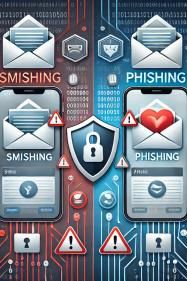In today’s digital world, email inboxes are often flooded with unwanted messages. Two of the most common types of these emails are spam and phishing.
While they may seem similar they serve different purposes and pose varying levels of risk to your personal and financial security. Understanding spam vs phishing is key to protecting your information and keeping your email communications secure. At Arsen, we train employees to recognize these threats and respond appropriately. Let’s dive into the definitions and differences between spam and phishing.
What is Spam?
Spam refers to unsolicited and irrelevant messages sent to a large number of recipients. Most commonly seen as promotional emails, spam usually aims to advertise products, services, or events. Spam can clutter your inbox and be a nuisance, but it is generally not designed to cause direct harm.
Characteristics of Spam
- Mass Distribution: Spam emails are sent in bulk, targeting thousands or even millions of recipients, often without their consent.
- Promotional Content: The content of spam emails typically includes advertising for products, services, or events. Common examples include promotional sales, newsletters, and subscription offers.
- Not Always Malicious: While spam can sometimes contain links to dubious websites, it is not inherently malicious like phishing. Its main goal is to grab attention or sell something.
Risks of Spam
Although spam is not as dangerous as phishing, it can still pose risks. Some spam emails may contain links to insecure websites, resulting in potential malware infections. It can also be a gateway to more sophisticated attacks if a spam email tricks you into signing up for questionable services.
What is Phishing?
Phishing is a cyberattack that uses deceit to steal sensitive information, such as passwords, credit card numbers, or personal identification details. Phishing emails impersonate legitimate organizations or contacts, aiming to trick recipients into divulging private information or clicking on malicious links.
Characteristics of Phishing
- Targeted Deception: Unlike spam, phishing emails are crafted to mimic messages from trusted entities like banks, online services, or colleagues. They often include official-looking logos and language to appear authentic.
- Malicious Intent: Phishing emails include links to fake websites, malicious attachments, or requests for sensitive information. The goal is to steal personal or financial information, or to gain unauthorized access to accounts.
- Urgency: Phishing messages often create a sense of urgency, pressuring recipients to act quickly. Common tactics include warnings about compromised accounts or urgent payment requests.
Risks of Phishing
Phishing is far more dangerous than spam. Falling for a phishing scam can result in financial loss, identity theft, or unauthorized access to accounts. Phishing can also lead to malware infections, compromising the security of your devices and networks.
Spam vs Phishing: Key Differences
While both spam and phishing involve unsolicited emails, their purposes and risks differ significantly.
- Intent: The main difference between spam vs phishing is intent. Spam is generally sent for promotional purposes, while phishing is designed to steal sensitive information or cause harm.
- Content: Spam usually contains generic advertising, whereas phishing emails are crafted to look like legitimate communications from trusted sources.
- Risk Level: Spam is primarily an annoyance, though it can sometimes lead to security risks. Phishing, on the other hand, is a direct cyber threat with potentially severe consequences.
How to Protect Yourself
Use Email Filters: Set up spam filters in your email client to automatically detect and block unwanted messages. Many email services have built-in filters for spam and phishing attempts.
Inspect Links and Senders: Always inspect links and sender addresses in emails. Avoid clicking on links or downloading attachments from unknown or suspicious sources.
Educate Employees: Awareness is crucial. At Arsen, we provide training to help employees distinguish between spam and phishing and respond appropriately to potential threats.
Conclusion
Knowing the difference between spam vs phishing is crucial for safeguarding your email communications and personal data. While spam is often harmless advertising, phishing is a dangerous tactic designed to steal sensitive information. By recognizing the key differences and implementing protective measures, you can enhance your email security and protect your digital assets.
At Arsen, we offer comprehensive cybersecurity training to help you and your organization stay vigilant against these threats.

